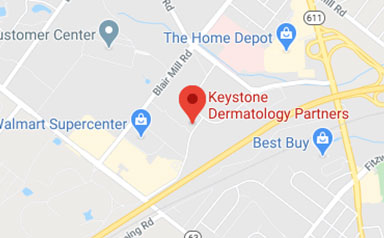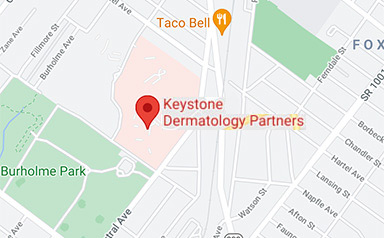Please click on a category below to expand and read or download instructions.
-
Wound Care Following a Shave Biopsy
What should I expect?
- The biopsy site will have a thin rim of redness and be tender to the touch for up to 2-3 weeks.
- Sometimes treated sites will begin to bleed 1-2 hours after the biopsy. If this happens, simply hold continuous firm pressure with a paper towel or gauze to the wound for 20 minutes without peeking. If the bleeding continues, repeat holding pressure for a second 20 minute period.
- Depending on the site of the biopsy, there may be some soreness at the treated site for 2-3 days. For most patients, taking an over the counter pain reliever such as acetaminophen (Tylenol) or ibuprofen (Advil, Motrin) will provide good pain relief.
- You will be contacted 7-10 days following the biopsy to review your results. If this does not happen, you must contact the office.
What should I do?
- Keep the bandage over the treated area on overnight.
- In the morning, it is safe to remove the bandage and shower. Just allow the soapy water to gently run over the wound. Do not rub or aggressively clean the biopsy site.
- Apply Vaseline or Aquaphor healing ointment to the biopsy site 3-4x/ day for three days. The ointment will help the wound heal more quickly and minimize scarring. We prefer Vaseline or Aquaphor to antibiotic ointment due to the increase in allergic reactions to antibiotic ointments such as Neosporin.
- You may choose to cover the wound with a bandage to keep the ointment from staining your clothing.
Downloadable PDF: Wound Care Following a Shave Biopsy
-
Wound Care Following Cryotherapy
What should I expect?
- The treated area may sting or burn for 10-15 minutes following treatment. After that, the area may feel sore for 1-2 days You may take an over the counter pain reliever such as acetaminophen (Tylenol) or ibuprofen (Motrin, Advil) every 6 hours as needed for pain.
- The site will become pink, red, and swollen soon after treatment and may look worse 2-3 days following treatment. It is not uncommon to develop a blister or scab.
- The scab will most likely fall off 1-2 weeks after treatment leaving a pink area behind. The color and texture of this area will gradually improve over time.
What should I do?
- You may gently wash the area with soap and water while in the shower. Do not rub or aggressively wash the treated site.
- Allow the scab and blister to heal on their own. They may act as sterile bandages so its best not to disturb them.
When should I call you?
- If you have any other questions or concerns, please call. We know this can be a scary and uncomfortable experience, we want to be there to support you.
Downloadable PDF: Wound Care Following Cryotherapy
-
Wound Care Following Surgery On Your Face
What should I do?
- Keep the pressure bandage over the treated area on overnight.
- In the morning, it is safe to remove the bandage and shower. Just allow the soapy water to gently run over the wound. Do not rub or aggressively clean the biopsy site.
- Apply Vaseline or Aquaphor healing ointment to the biopsy site 3-4x/ day for three days. The ointment will help the wound heal more quickly and minimize scarring. We prefer Vaseline or Aquaphor to antibiotic ointment due to the increase in allergic reactions to antibiotic ointments such as Neosporin.
- You may choose to cover the wound with a bandage to keep the ointment from staining your clothing.
- For the first two days following surgery, you should take an over the counter pain reliever such as acetaminophen (Tylenol) or ibuprofen (Motrin, Advil) every 6 hours even if you are not in pain. Its important to take the medication to “stay ahead” of the pain; once the area begins to hurt, its much harder to control the pain. Your physician may also prescribe a narcotic pain reliever depending on the extent of your surgery.
- You may be instructed to follow up in 1-2 weeks to have your sutures removed.
What should I expect?
- The suture line will develop a thin line of redness and may be tender for several days following surgery.
- It is common to develop swelling for 2-5 days following surgery. Swelling is especially common around the eyes as this skin may be looser than surrounding areas on the forehead, nose, and cheeks. This will improve on its own over time.
- Sometimes sutured areas may begin to bleed 1-2 hours after the surgery. If this happens, simply hold continuous firm pressure with a paper towel or gauze to the wound for 20 minutes without peeking. If the bleeding continues, repeat holding pressure for a second 20 minute period.
When should I call you?
- If there is persistent bleeding after holding pressure for two twenty minute sessions, then please call.
- If the wound develops a foul smell, becomes more painful after three days following surgery, starts to drain thick gray-yellow pus, or you develop fever or chills, please call.
- If you have any other questions or concerns, please call. We know this can be a scary and uncomfortable experience, we want to be there to support you.
Downloadable PDF: Wound Care Following Surgery on Your Face
-
Wound Care Following Surgery On Your Face
What should I do?
- Keep the pressure bandage over the treated area on overnight.
- In the morning, it is safe to remove the bandage and shower. Just allow the soapy water to gently run over the wound. Do not rub or aggressively clean the biopsy site.
- Apply Vaseline or Aquaphor healing ointment to the biopsy site 3-4x/ day for three days. The ointment will help the wound heal more quickly and minimize scarring. We prefer Vaseline or Aquaphor to antibiotic ointment due to the increase in allergic reactions to antibiotic ointments such as Neosporin.
- You may choose to cover the wound with a bandage to keep the ointment from staining your clothing.
- For the first two days following surgery, you should take an over the counter pain reliever such as acetaminophen (Tylenol) or ibuprofen (Motrin, Advil) every 6 hours even if you are not in pain. Its important to take the medication to “stay ahead” of the pain; once the area begins to hurt, its much harder to control the pain. Your physician may also prescribe a narcotic pain reliever depending on the extent of your surgery.
- You may be instructed to follow up in 1-2 weeks to have your sutures removed.
What should I expect?
- The suture line will develop a thin line of redness and may be tender for several days following surgery.
- It is common to develop swelling for 2-5 days following surgery. Swelling is especially common around the eyes as this skin may be looser than surrounding areas on the forehead, nose, and cheeks. This will improve on its own over time.
- Sometimes sutured areas may begin to bleed 1-2 hours after the surgery. If this happens, simply hold continuous firm pressure with a paper towel or gauze to the wound for 20 minutes without peeking. If the bleeding continues, repeat holding pressure for a second 20 minute period.
When should I call you?
- If there is persistent bleeding after holding pressure for two twenty minute sessions, then please call.
- If the wound develops a foul smell, becomes more painful after three days following surgery, starts to drain thick gray-yellow pus, or you develop fever or chills, please call.
- If you have any other questions or concerns, please call. We know this can be a scary and uncomfortable experience, we want to be there to support you.
Downloadable PDF: Wound Care Following Surgery on Your Face
-
Wound Care Following Surgery On Your Arm or Hand
What should I expect?
- The suture line will develop a thin line of redness and may be tender for several days following surgery.
- Sometimes sutured areas may begin to bleed 1-2 hours after the surgery. If this happens, simply hold continuous firm pressure with a paper towel or gauze to the wound for 20 minutes without peeking. If the bleeding continues, repeat holding pressure for a second 20 minute period.
What should I do?
- Keep the pressure bandage over the treated area on overnight.
- In the morning, it is safe to remove the bandage and shower. Just allow the soapy water to gently run over the wound. Do not rub or aggressively clean the biopsy site.
- Keep your arm and hand elevated for the first week as much as possible.
- Avoid bending, lifting, or any exercise that will increase your blood pressure or heart rate. These actions will increase the risk of dehiscence (wound spreading apart), delayed healing, infection, and poor scarring.
- Apply Vaseline or Aquaphor healing ointment to the biopsy site 3-4x/ day for three days. The ointment will help the wound heal more quickly and minimize scarring. We prefer Vaseline or Aquaphor to antibiotic ointment due to the increase in allergic reactions to antibiotic ointments such as Neosporin.
- You may choose to cover the wound with a bandage to keep the ointment from staining your clothing.
- For the first two days following surgery, you should take an over the counter pain reliever such as acetaminophen (Tylenol) or ibuprofen (Motrin, Advil) every 6 hours even if you are not in pain. Its important to take the medication to “stay ahead” of the pain; once the area begins to hurt, its much harder to control the pain. Your physician may also prescribe a narcotic pain reliever depending on the extent of your surgery.
- You may be instructed to follow up in 2 weeks to have your sutures removed.
When should I call you?
- If there is persistent bleeding after holding pressure for two twenty minute sessions, then please call.
- If the wound develops a foul smell, becomes more painful after three days following surgery, starts to drain thick gray-yellow pus, or you develop fever or chills, please call.
- If you have any other questions or concerns, please call. We know this can be a scary and uncomfortable experience, we want to be there to support you.
Downloadable PDF: Wound Care Following Surgery on Your Arm or Hand
-
Wound Care Following Surgery On Your Chest, Back, or Stomach
What should I expect?
- The suture line will develop a thin line of redness and may be tender for several days following surgery.
- Sometimes sutured areas may begin to bleed 1-2 hours after the surgery. If this happens, simply hold continuous firm pressure with a paper towel or gauze to the wound for 20 minutes without peeking. If the bleeding continues, repeat holding pressure for a second 20 minute period.
What should I do?
- Keep the pressure bandage over the treated area on overnight.
- In the morning, it is safe to remove the bandage and shower. Just allow the soapy water to gently run over the wound. Do not rub or aggressively clean the biopsy site.
- Keep your leg elevated for the first week as much as possible.
- Avoid bending, lifting, or any exercise that will increase your blood pressure or heart rate. These actions will increase the risk of dehiscence (wound spreading apart), delayed healing, infection, and poor scarring.
- Apply Vaseline or Aquaphor healing ointment to the biopsy site 3-4x/ day for three days. The ointment will help the wound heal more quickly and minimize scarring. We prefer Vaseline or Aquaphor to antibiotic ointment due to the increase in allergic reactions to antibiotic ointments such as Neosporin.
- For the first two days following surgery, you should take an over the counter pain reliever such as acetaminophen (Tylenol) or ibuprofen (Motrin, Advil) every 6 hours even if you are not in pain. Its important to take the medication to “stay ahead” of the pain; once the area begins to hurt, its much harder to control the pain. Your physician may also prescribe a narcotic pain reliever depending on the extent of your surgery.
- You may be instructed to follow up in 2 weeks to have your sutures removed.
When should I call you?
- If there is persistent bleeding after holding pressure for two twenty minute sessions, then please call.
- If the wound develops a foul smell, becomes more painful after three days following surgery, starts to drain thick gray-yellow pus, or you develop fever or chills, please call.
- If you have any other questions or concerns, please call. We know this can be a scary and uncomfortable experience, we want to be there to support you.
Downloadable PDF: Wound Care Following Surgery on Your Chest, Back, or Stomach
-
Wound Care Following Surgery On Your Leg or Foot
What should I expect?
- The suture line will develop a thin line of redness and may be tender for several days following surgery.
- Sometimes sutured areas may begin to bleed 1-2 hours after the surgery. If this happens, simply hold continuous firm pressure with a paper towel or gauze to the wound for 20 minutes without peeking. If the bleeding continues, repeat holding pressure for a second 20 minute period.
What should I do?
- Keep the pressure bandage over the treated area on overnight.
- In the morning, it is safe to remove the bandage and shower. Just allow the soapy water to gently run over the wound. Do not rub or aggressively clean the biopsy site.
- Keep your leg elevated for the first week as much as possible.
- Avoid bending, lifting, or any exercise that will increase your blood pressure or heart rate. These actions will increase the risk of dehiscence (wound spreading apart), delayed healing, infection, and poor scarring.
- Apply Vaseline or Aquaphor healing ointment to the biopsy site 3-4x/ day for three days. The ointment will help the wound heal more quickly and minimize scarring. We prefer Vaseline or Aquaphor to antibiotic ointment due to the increase in allergic reactions to antibiotic ointments such as Neosporin.
- Re-wrap your leg or foot with a compression bandage (ACE wrap or compression stocking) twice a day until the sutures are removed. This is very important to ensure optimal healing.
- For the first two days following surgery, you should take an over the counter pain reliever such as acetaminophen (Tylenol) or ibuprofen (Motrin, Advil) every 6 hours even if you are not in pain. Its important to take the medication to “stay ahead” of the pain; once the area begins to hurt, its much harder to control the pain. Your physician may also prescribe a narcotic pain reliever depending on the extent of your surgery.
- You may be instructed to follow up in 2 weeks to have your sutures removed.
When should I call you?
- If there is persistent bleeding after holding pressure for two twenty minute sessions, then please call.
- If the wound develops a foul smell, becomes more painful after three days following surgery, starts to drain thick gray-yellow pus, or you develop fever or chills, please call.
- If you have any other questions or concerns, please call. We know this can be a scary and uncomfortable experience, we want to be there to support you.
Downloadable PDF: Wound Care Following Surgery on Your Leg or Foot
-
Who do I contact with questions?
- During regular office hours, please call us at (215) 390-1449.
- For urgent matters during evenings, weekends, or other times that the office is not open, please call Dr. Perlis on his mobile phone.
- For non-urgent matters, you may also reach us by e-mail at nursing@keyderm.com





